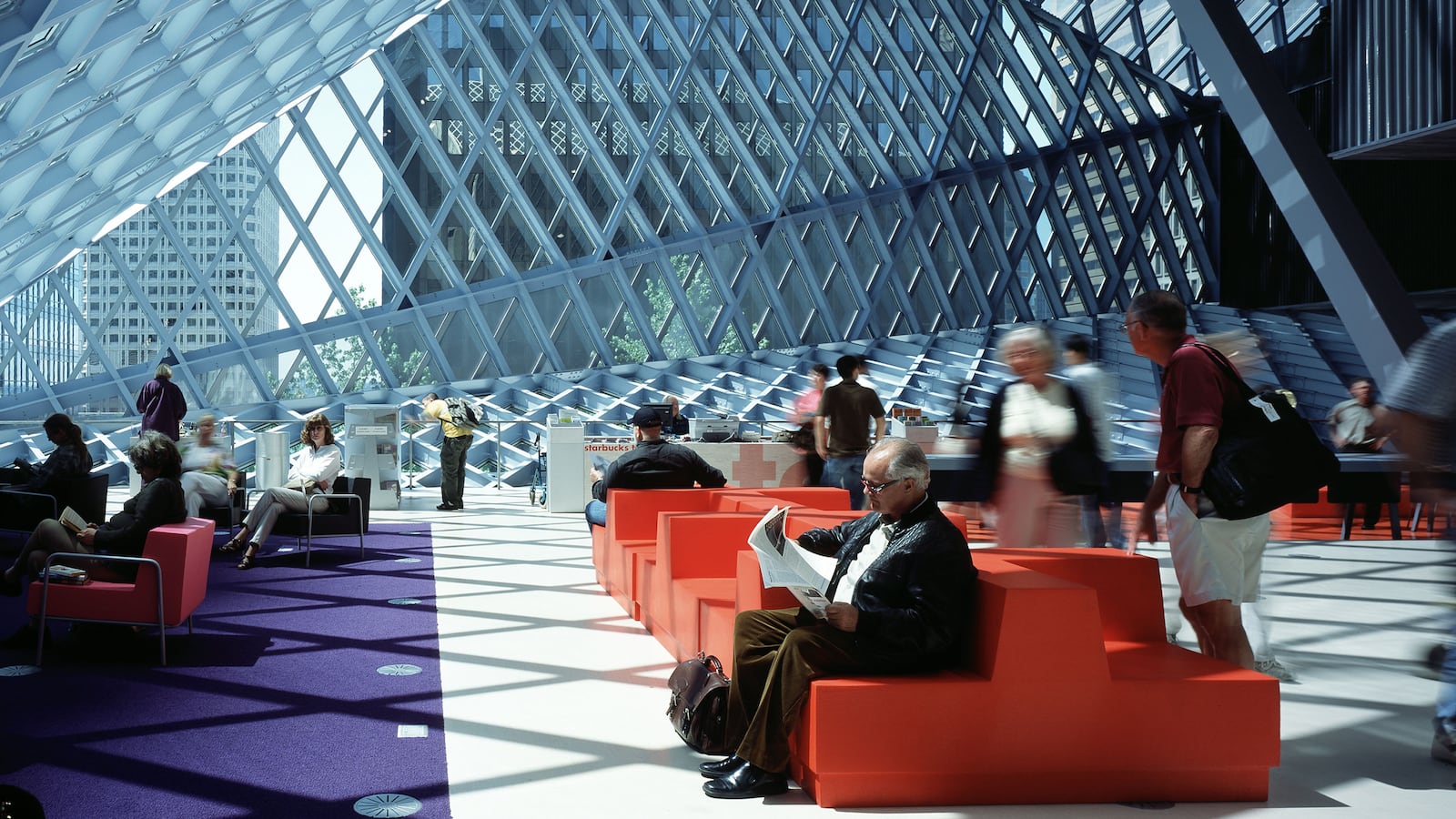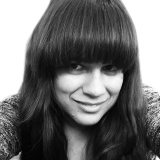You don’t have to look far to find evidence of the variety of visitors who visit Seattle’s Central Library. Located on the basement floor, amidst a globe-spanning collection of DVDs, is a work from artist Ann Hamilton which allows visitors to walk all over on 556 first lines of books, etched into the hardwood floor in Arabic, Chinese, English, French, German, Italian, Japanese, Korean, Russian, Spanish, and Vietnamese. Yes, it’s a small detail in a large building, one that could literally get lost underfoot. But it’s embellishments like these that make Seattle Public Library-Central the latest selection for The Daily Beast’s monthly series, The World’s Most Beautiful Libraries.
Opened in 2004, the Seattle Central Library represented a turning point for Seattle. Funded via a $196.4 million bond measure, called “Libraries for All,” (With a 20-million-dollar assist from Bill Gates), all the libraries in the area were able to undergo some kind of update or expansion. However, it was the Central Library, which had outgrown its previous digs first opened in 1972, that was given an eleven-story, 362,987 square-foot makeover. Which isn’t of course to say that previous iterations weren’t impressive. The library was once housed in the former home of the city’s richest resident, Henry Yesler before burning down, and a Carnegie Library occupied the spot until the 1970s.
After fifteen years in her job, Valerie Wonder, downtown regional manager, has seen the kind of joy having a functioning library has given the community. It’s a third place, aka a hangout that isn’t work or home, and where buying a latte isn’t the price of admission.
“I think that people have an incredible sense of pride about their public library system in a way that they didn't before,” she says. “I've lived in Seattle since the early 90s, it's different, I think because of this library.”

Designed as a series of three rectangles stacked on top of each other at slightly skewed angles Rem Koolhaas by and Joshua Prince-Ramus, the building is a showy addition to the office-building populated downtown. Koolhas, of course, is the Pritzker Prize-winning architect behind the CCTV headquarters in Beijing and the De Rotterdam complex. With walls composed of 9,996 panes of glass (a fact that Wonder rattles off without hesitation), the library looks more like a greenhouse than a library, which given Seattle’s notoriously gloomy weather, might have been exactly the point. Being able to look down from the upper story into the airy atrium, with areas demarcated only by rugs also gives the building an additional sense of space, as emphasized by patrons sprawled out on the building’s various chairs and couches. This is a library that embraced social distancing before it became the preferred lifestyle choice.
Like most creative leaps, it took time for the Central Library’s unorthodox design to be embraced. In 2008, one resident noted that, “the library is an insult to the volumes of great literature to be housed within it,” while another local creatively noted it was “gigantic fist thrusting out from the downtown soil, its 20-story middle digit upraised to the infinite.”
But there’s something to be said for novelty. Since its opening, film crews for 2019 comedy Cate Blanchett comedy Where'd You Go, Bernadette and illustrious, iCarly have both filmed at the library. Likewise, a legion of influencers have stopped by. With over 25,219 entries under #seattlepubliclibrary and an endless stream of photos if you check the location tag, the Seattle Public Library is one of the most instagramed libraries in the world. (Wonder encourages grabbling a few snaps as long as visitors aren’t being blocked in the process.) After all, why wouldn't you want to snap a selfie in a building that New York Times has referred to as a “The library that puts on its fishnets and hits the disco?”

The library stands out because Koolhaas and Prince-Ramus rethought common elements. Like the Centre Pompidou in Paris, the functionality of the building isn’t hidden from view, but rather highlighted. Brightly. Hallways are washed in red. And transportation throughout the building is highlighted in other primary shades.
“The architects did intend that the stairs or the escalator have this bright green color,” says Wonder. “The elevators have yellow, the color of vertical movement…I do think there was some romanticizing about feeling their way through the building.”
At this, she laughs. “Signs were added later.”
Traditionalists will be comforted that the top floor reading room echoes conventional aesthetics of a university library. However, as a whole, the building functions as a dramatic rethinking of library tropes. (For evidence, see Lynne Yamamoto’s “Of Memory,” a sculpture of decommissioned card catalogs, hanging next to the Hugh and Jane Ferguson Seattle Room.) On levels six though ten, a large portion of the collection’s 1.5 million books are laid out in a spiral pattern, accessible through a series of interconnected ramps. While the Dewey Decimal is still king, so you can actually find what you’re looking for, the configuration allows for a certain amount of bookworm-friendly happenstance.
“The point was to create a kind of single, undivided sequence, because we felt that one of the points of a library was that there are accidents and that you find yourself in areas where you didn’t expect to be, and where you kind of look at books that are not necessarily the books that you’re aiming for, Koolhass told Seattle Times in 2008. “So it was to create a kind of almost arbitrariness — or to create a kind of walking experience, an almost kind of urban walk.”
As Wonder points out, form—no matter how eye-catching—never outweighs function. Since its inception, Seattle Central Library has become an important hub, and not only for people seeking books (or souvenirs from their well-stocked gift shop). Often she’s serenaded from the library’s music rooms on her way to a meeting. And in response to the pandemic, with patrons complaining that they had no internet access or plugs, rapid cell phone chargers were installed on the fifth floor, where the majority of their 400 computers are also located.
However, her favorite elements are the community programs, held in the 275 person Microsoft Auditorium. While these events have included notable literary figures like Anna Quindlen, Amy Tan, and John Green (and are often available in podcast form), the most notable events are those that capture the spirit of the community. Panels like “Exploring Black Brilliance and Black Joy Through Storytelling,” and classes on finding a way to citizenship are regularly scheduled and widely attended. After all, Wonder reasons, a gorgeous building is nothing if it doesn’t reflect the people that use it.
“It’s the work that the team has done to platform community voices,” says Wonder. “Like any large urban city, homelessness, has been on the rise for a decade and a half. We did a program to address that, probably five years ago so. We had a panel, and there's always an effort to make sure that the people who are most affected by the issue are the ones whose voices are platformed. So, we had a panel of community members talking about their experience with homelessness, for about 300 people. That sort of spirit that creates a community, that's the sort of thing that makes me feel proud.”
Correction: A previous version of this article misstated the number of panes of glass as 999,996.

